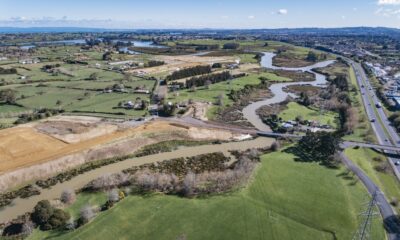Business
New Bill Streamlines Foreign Investment Approvals in New Zealand

The New Zealand Government has introduced the **Overseas Investment (Amendment) Bill**, aimed at enhancing the country’s appeal to foreign investors. This legislation marks a significant shift towards a more welcoming environment for overseas capital, particularly beneficial for the nation’s infrastructure and productivity. While the new bill includes a streamlined **15-day approval process**, it retains certain restrictions on investments in sensitive sectors such as fishing quotas, farmland, and housing.
The bill is an essential step forward for New Zealand, which faces a pressing need for substantial investment in infrastructure. According to Bryce Wilkinson, a prominent commentator on economic policy, the increased openness to foreign investment is crucial for addressing these infrastructure challenges. He notes that billions of dollars are essential for the country to modernize and expand its facilities effectively.
Key Features of the Amendment
The **Overseas Investment (Amendment) Bill** simplifies the investment approval process significantly. By reducing ministerial discretion, the bill aims to expedite decisions that investors often find cumbersome and time-consuming. This change is expected to attract more foreign capital, which is vital for fostering economic growth.
Despite its positive aspects, the bill continues to uphold the “privilege” presumption for certain investments. This means that investments in sensitive areas, such as fishing quotas, farmland, and housing, will still face additional scrutiny. Critics argue that these restrictions may deter some investors who are hesitant to navigate the complex regulations surrounding these sectors.
Wilkinson emphasizes that while the bill is a step in the right direction, it does not fully address the barriers that foreign investors face in New Zealand. He advocates for further reforms that could simplify the investment landscape even more, encouraging greater foreign participation in the local economy.
Implications for New Zealand’s Economy
The introduction of the **Overseas Investment (Amendment) Bill** is expected to have significant implications for New Zealand’s economy. Increased foreign investment can lead to job creation, improved infrastructure, and enhanced productivity. As the country looks to recover from various economic challenges, attracting foreign capital will be crucial.
Moreover, the bill aligns with broader global trends where nations are increasingly recognizing the importance of foreign investment in driving economic development. By modernizing its investment regulations, New Zealand positions itself as a competitive destination for international investors.
In conclusion, while the **Overseas Investment (Amendment) Bill** represents a positive shift towards embracing foreign investment, the Government may need to consider further adjustments to fully unlock the potential benefits of overseas capital. As New Zealand navigates its economic future, the balance between attracting investment and protecting national interests will remain a vital consideration.
-

 Sports2 months ago
Sports2 months agoNetball New Zealand Stands Down Dame Noeline Taurua for Series
-

 Entertainment2 months ago
Entertainment2 months agoTributes Pour In for Lachlan Rofe, Reality Star, Dead at 47
-

 Entertainment2 weeks ago
Entertainment2 weeks agoNew ‘Maverick’ Chaser Joins Beat the Chasers Season Finale
-

 Sports2 months ago
Sports2 months agoSilver Ferns Legend Laura Langman Criticizes Team’s Attitude
-

 Politics3 weeks ago
Politics3 weeks agoNetball NZ Calls for Respect Amid Dame Taurua’s Standoff
-

 Entertainment2 months ago
Entertainment2 months agoKhloe Kardashian Embraces Innovative Stem Cell Therapy in Mexico
-

 Sports2 months ago
Sports2 months agoGaël Monfils Set to Defend ASB Classic Title in January 2026
-

 World3 months ago
World3 months agoPolice Arrest Multiple Individuals During Funeral for Zain Taikato-Fox
-

 Entertainment4 weeks ago
Entertainment4 weeks agoTyson Fury’s Daughter Venezuela Gets Engaged at Birthday Bash
-

 Sports4 weeks ago
Sports4 weeks agoHeather McMahan Steps Down as Ryder Cup Host After Controversy
-

 Entertainment4 weeks ago
Entertainment4 weeks agoTyson Fury’s Daughter Venezuela Gets Engaged at Birthday Bash
-

 World4 weeks ago
World4 weeks agoNew Zealand Firefighters Plan Strike on October 17 Over Pay Disputes





















